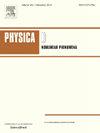On the instability and stability of non-homogeneous fluid in a bounded domain under the influence of a general potential
IF 2.7
3区 数学
Q1 MATHEMATICS, APPLIED
引用次数: 0
Abstract
We investigate the instability and stability of specific steady-state solutions of the two-dimensional non-homogeneous, incompressible, and viscous Navier–Stokes equations under the influence of a general potential . This potential is commonly used to model fluid motions in celestial bodies. First, we demonstrate that the system admits only steady-state solutions of the form , where and satisfy the hydrostatic balance condition . Additionally, the relationship between and the potential function is constrained by the condition , which allows us to express as . Second, when there exists a point such that , we establish the linear instability of these solutions. Furthermore, we demonstrate their nonlinear instability in both the Lipschitz and Hadamard senses through detailed nonlinear energy estimates. This instability aligns with the well-known Rayleigh–Taylor instability. Our study significantly extends and generalizes the existing mathematical results, which have predominantly focused on the scenarios involving a uniform gravitational field characterized by . Finally, we show that these steady states are linearly stable provided that holds throughout the domain. Moreover, they exhibit nonlinear stability when is a negative constant.
一般势作用下有界区域内非均匀流体的不稳定性和稳定性
我们研究了二维非齐次、不可压缩和粘性Navier-Stokes方程在一般势f影响下的特定稳态解的不稳定性和稳定性。该势通常用于模拟天体中的流体运动。首先,我们证明了系统只允许形式为ρ,V,p=ρ0,0,P0的稳态解,其中P0和ρ0满足流体静力平衡条件∇P0= - ρ0∇f。此外,ρ0与势函数f之间的关系受∂yρ0,−∂xρ0⋅∂xf,∂yf=0的条件约束,这使得我们可以将∇ρ0表示为hx,y∇f。其次,当存在点x0,y0使得hx0,y0>;0时,我们建立了这些解的线性不稳定性。此外,我们通过详细的非线性能量估计证明了它们在Lipschitz和Hadamard感觉下的非线性不稳定性。这种不稳定性与著名的瑞利-泰勒不稳定性一致。我们的研究极大地扩展和推广了现有的数学结果,这些结果主要集中在以∇f=(0,g)为特征的均匀引力场的情况下。最后,我们证明了这些稳态是线性稳定的,只要hx,y<;0在整个定义域保持不变。此外,当hx,y为负常数时,它们表现出非线性稳定性。
本文章由计算机程序翻译,如有差异,请以英文原文为准。
求助全文
约1分钟内获得全文
求助全文
来源期刊

Physica D: Nonlinear Phenomena
物理-物理:数学物理
CiteScore
7.30
自引率
7.50%
发文量
213
审稿时长
65 days
期刊介绍:
Physica D (Nonlinear Phenomena) publishes research and review articles reporting on experimental and theoretical works, techniques and ideas that advance the understanding of nonlinear phenomena. Topics encompass wave motion in physical, chemical and biological systems; physical or biological phenomena governed by nonlinear field equations, including hydrodynamics and turbulence; pattern formation and cooperative phenomena; instability, bifurcations, chaos, and space-time disorder; integrable/Hamiltonian systems; asymptotic analysis and, more generally, mathematical methods for nonlinear systems.
 求助内容:
求助内容: 应助结果提醒方式:
应助结果提醒方式:


